mobile Ansicht, to the English Version tap the flag
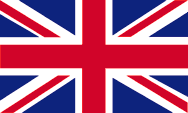

- Republik Kabardino-Balkarien
- Föderaler Bestandteil der Russischen Föderation (Russland)
- Eigenbezeichnung: Kèbèrdej-Balkèr Respublika
• Flagge
• inoffizielle Flaggen
• historische Flaggen
• Bedeutung/Ursprung der Flagge
• Wappen
• Landkarte
• Zahlen und Fakten
• Geschichte
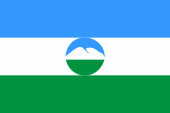
Nationalflagge,
Seitenverhältnis = 2:3,
Quelle, nach: Flags of the World




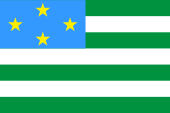
Kabardien,
Nationalflagge der Kabardiner,
Seitenverhältnis = 2:3,
Quelle, nach: Flags of the World




Balkarien,
Nationalflagge der Balkaren,
Seitenverhältnis = 2:3,
Quelle, nach: Flags of the World




Nationalflagge der Balkaren,
Variante,
Seitenverhältnis = 2:3,
Quelle, nach: Flags of the World




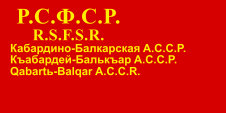
1937–1938,
Flagge der Autonomen Sowjetrepublik,
Seitenverhältnis = 1:2,
Quelle, nach: World Statesmen



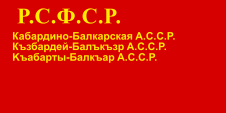
1938–1944,
Flagge der Autonomen Sowjetrepublik,
Seitenverhältnis = 1:2,
Quelle, nach: World Statesmen



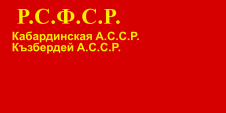
1945–1954,
Flagge der Autonomen Sowjetrepublik,
Seitenverhältnis = 1:2,
Quelle, nach: World Statesmen




1954–1957,
Flagge der Autonomen Sowjetrepublik,
Seitenverhältnis = 1:2,
Quelle, nach: World Statesmen



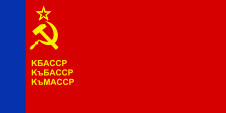
1957–1978,
Flagge der Autonomen Sowjetrepublik,
Seitenverhältnis = 1:2,
Quelle, nach: World Statesmen




1978–1992,
Flagge der Autonomen Sowjetrepublik,
Seitenverhältnis = 1:2,
Quelle, nach: World Statesmen



siehe auch:
Flaggengeschichte der Sowjetrepubliken der UdSSR

Die Flagge von Kabardino-Balkarien vereinigt die Farben Blau, Weiß und Grün, welche jeweils Bestandteile der inoffiziellen Flaggen von Kabardien und Balkarien sind. In der Mitte das Staatssymbol, welches die Silhouette des 5.642 Meter hohen Berges Elbrus zeigt. Das Blau steht für den Himmel, das Weiß für die schneebedeckten Berge des Kaukasus und das Grün für die Felder des Landes. Die inoffizielle Flagge von Kabardien ähnelt von der Gestaltung her sehr der Flagge von Abchasien. Die Kombination der grün-weißen Streifen soll daher offenber die Toleranz der kaukasischen Völker ausdrücken. Über die Bedeutung der vier Sterne ist bisher nichts bekannt. Die inoffizielle Flagge Balkariens zeigt waagerecht gestreift die Farben Blau, Weiß und Blau mit einem fünfzackigen roten Stern auf einer goldenen Scheibe in der Mitte. Eine andere Variante zeigt auf blauem Grund und zwischen zwei weißen waagerechten weißen Streifen die weiße Silhouette des Berges Elbrus. Die Flaggen, die zu Sowjet-Zeiten verwendet wurden, entsprachen alle dem immer gleichen Schema, wie es für Sowjetische Autonome Republiken vorgesehen war: Zwischen 1923 und 1937 oft nur ein einfabiges rotes Flaggentuch mit einer goldenen Inschrift, die den Landesnamen zeigte. Manchmal nur als Abkürzung, manchmal mit vollem Namen, manchmal nur in Russisch oder auch mehrsprachig. Ab etwa 1937 wurden manchmal noch Hammer, Sichel und Stern ergänzt. Ab etwa der Mitte der 50-er Jahre wurden mehrfarbige Flaggen für die Republiken der Sowjetunion eingeführt, deren Strickmuster die untergeordneten Autonomen Sowjetrepubliken zu übernehmen hatten.
Quelle:
Flaggen Enzyklopädie,
Volker Preuß


Wappen von Kabardino-Balkarien,
Quelle: Russiatrek

geographische Lage in Russland:
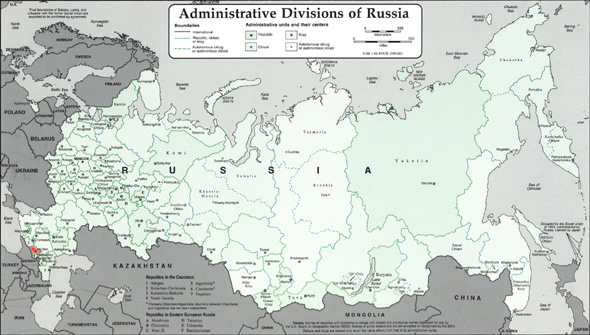
Quelle: Freeware, russiamap.org, modyfied by: Volker Preuß
vergrößern – hier klicken
Landkarte des Landes:

Quelle/Source: Russiatrek

Fläche: 12.470 km²
Einwohner: 860.000 (2010), davon 57% Kabardiner, 23% Russen, 13% Balkaren
Bevölkerungsdichte: 69 Ew./km²
Hauptstadt: Naltschik, 240.000 Ew. (2010)
Amtssprachen: Russisch, Kabardinisch, Balkarisch
Währung: russische Währung
Zeitzone (ab 28.03.2010): MEZ + 2 h
Zeitzone (bis 28.03.2010): MEZ + 3 h
Quelle:
Wikipedia (D)

1825–1858 · russische Eroberung
1921 · Errichtung der Sowjetdiktatur, Errichtung des Autonomen Gebietes der Kabardiner und des Nationalen Kreises der Balkaren
1936 · Errichtung des Autonomen Bezirks (Oblast) der Kabardiner und Balkaren durch Zusammenschluss des Autonomen Gebietes der Kabardiner mit dem Nationalen Kreis der Balkaren
1943–1944 · Deportation der Balkaren nach Sibirien
1957 · Rückkehr der Überlebenden
1991 · Proklamation der Autonomen Republik Kabardino-Balkarien
31.12.1991 · die Sowjetunion löst sich auf, die Verfassung der Russischen Sozialistischen Föderativen Sowjetrepublik (RSFSR, Russland), ein ehemaliger Teilstaat der Sowjetunion bleibt vorerst in Kraft
1992 · Proklamation der Republik Kabardino-Balkarien
25.12.1993 · eine neue Verfassung für Russland (Russische Föderation) tritt in Kraft, das Verhältnis zu den Gliedern der Föderation wird damit neu geregelt
Quelle:
Atlas zur Geschichte,
World Statesmen,
Russiatrek,
Die Völker der Erde

Surftipp:
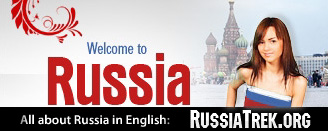

![]()



































